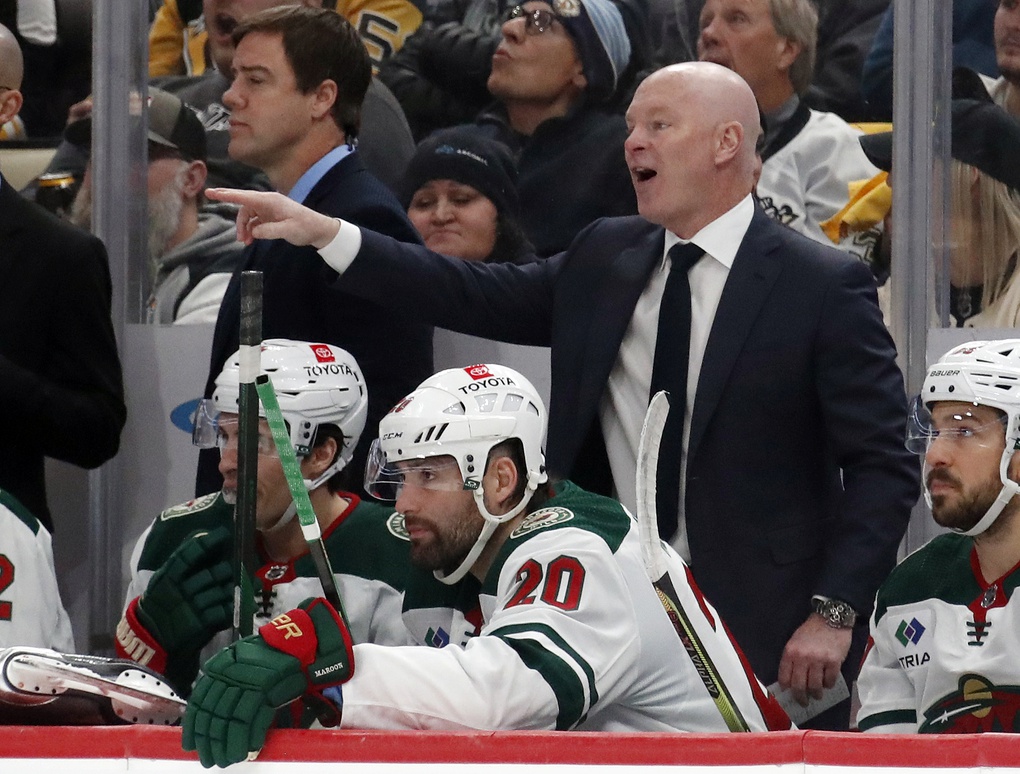
Other than "10-3 record," the best thing you can say about John Hynes' first impression as the Minnesota Wild's head coach is he has the team looking like themselves. At the start of the season, they looked adrift under Dean Evason. Their defense was leaking, the goaltending collapsed, and their stars were fizzling.
The Wild are back to winning games, and they're winning by the Wild Way: shutting down opponents and letting their stars and goaltending carry the day. Since November 28 (the day of the coaching change), the Wild are not only first in the NHL at allowing goals at 5-on-5 (1.51 per hour), but first in allowing expected goals (2.08 per hour).
That's great, especially for a rag-tag defense group missing Jonas Brodin for the past seven games and Jared Spurgeon for the last six. That kind of defense should drive winning to the point where their two-point deficit in the second Wild Card spot race seems manageable now.
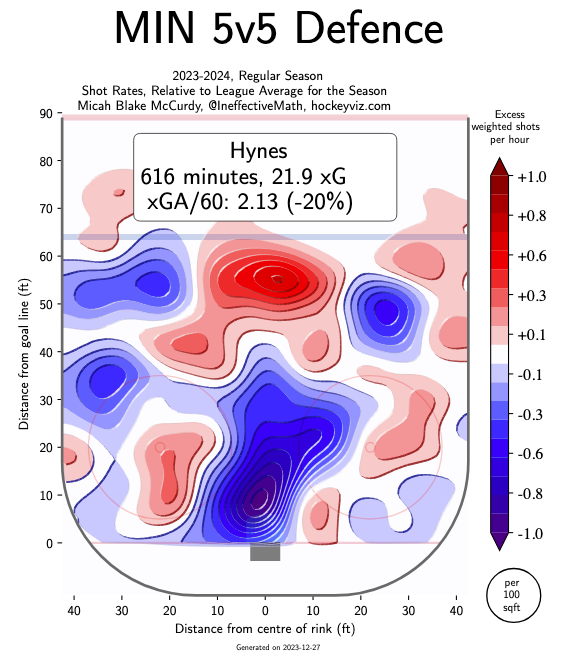
The only question now remains: Is that going to be good enough?
That was the formula for punching their ticket in the Wild's stretch of 10 postseason trips in 11 years. From 2012-13 to 2017-18, Minnesota coaches Mike Yeo and Bruce Boudreau defense-d their way to the playoffs with little star power to help them along. They duplicated the formula under the Evason regime, but with Kevin Fiala, then Kirill Kaprizov serving as a star offensive performer.
Hynes is looking great with the tried-and-true blueprint, but that hasn't been enough in the past. No one needs to be reminded that the Wild have lost their last eight postseason series, including seven in the first round.
In May, Bill Guerin stood before the media and told them, "They're not going to put our name on the Stanley Cup to get to the second round.... That's not our goal. Our goal is not to make it to the second round." But you still need to win that first round en route to a Stanley Cup Final. Is it the formula? Guerin doesn't think so; he's doubled down on his core. But it feels like Hynes needs more than to bring the Wild back to business as usual.
The defense is back in place, and the goaltenders are responding to the better protection. The offense is the missing piece. At surface level, Hynes has Minnesota's offense as good as ever. The team is scoring 2.87 goals per hour at 5-on-5, which is ninth in the NHL. Their stars are shining again. Kaprizov has six goals and 13 points, Boldy has eight goals and 11 points, and Marco Rossi has five goals and 10 points in those 13 games.
There's cause for concern under the hood, though. Upon Hynes' arrival, the Wild stepped up in their underlying numbers. Their expected goals numbers at 5-on-5 ticked up from 2.38 per hour under Evason to 2.51 under Hynes. The problem is their 2.51 figure still ranks in the league's bottom ten over that time. They're tied for 24th in the NHL in that span, with the Washington Capitals and Dallas Stars as the only current playoff teams who are worse.
It would seem like the Wild are still not shooting enough under Hynes, but interestingly enough, they're attempting significantly more shots. Before the coaching change, the Wild ranked 22nd in Corsi (total shot attempts) and 26th in Fenwick (total unblocked shot attempts) per hour at 5-on-5. But they jumped to fifth and 10th in those categories once Hynes stepped in, respectively.
So why are their expected goals so low? Let's take a look at their heat map:
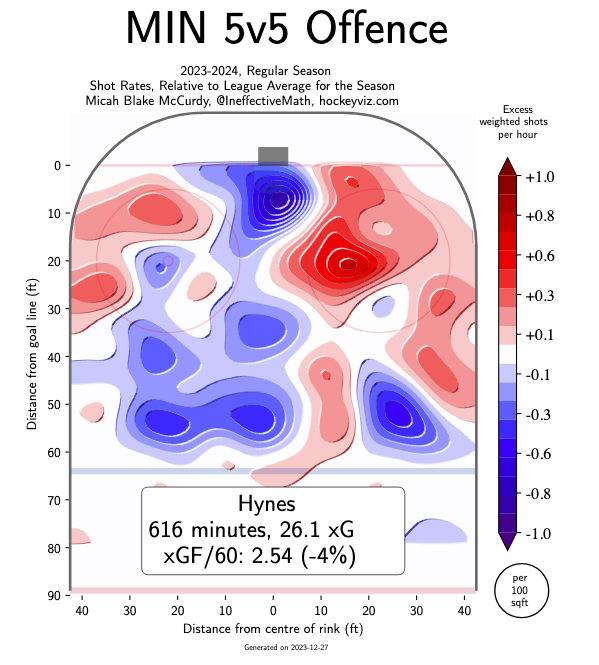
The Wild are getting the bulk of their scoring chances from the right side of the slot by the faceoff circle. In the high slot or by the left faceoff circle? Not so much. At the front of the net? Even fewer. Instead, they're taking shots from the point and by the boards on the left side of the zone when not shooting from that right faceoff dot.
Solving Minnesota's lack of high-quality shots is the way Hynes' Wild can take the next step. How can they do that?
In some ways, that's already in the works. Minnesota's top-six forwards: Kaprizov, Boldy, Rossi, Joel Eriksson Ek, Mats Zuccarello, and Marcus Johansson, are generally seeing an increase in expected goals for (xGF) under Hynes. Let's look at the before-and-after of their per-hour stats:
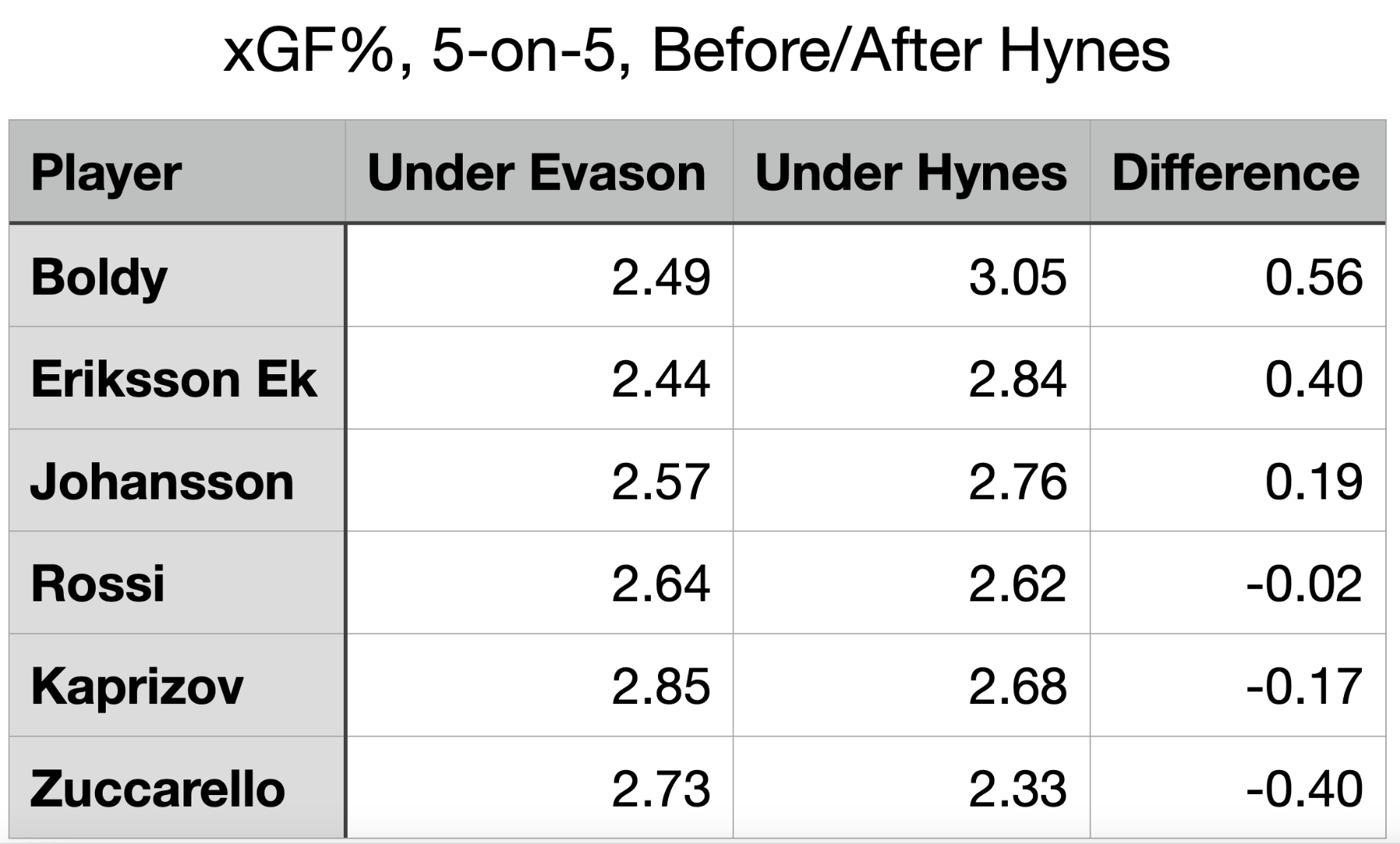
For the most part, we've seen the top six stay the same or improve, with Boldy and Eriksson Ek rising significantly. Kaprizov and Zuccarello are the only exceptions. Those make sense because the Wild often double-shift Kaprizov, and Zuccarello is dealing with injuries that have sidelined him.
With the top six generally performing to standards, the Wild's problem seems to be their vaunted depth. Hynes has largely dispensed with Evason's share-the-wealth philosophy and is currently deploying a top line with his three most impactful players in Kaprizov, Boldy, and Eriksson Ek.
That's come at the expense of players like Patrick Maroon and Ryan Hartman, who've both seen dramatic decreases in offense under Hynes. It's also been challenging to get depth players like Marcus Foligno, Freddy Gaudreau, and Connor Dewar to push the pace.
Maybe the true test of whether or not Minnesota can take a jump in offense will occur when Spurgeon and Brodin return. The blueline is heavily taxed right now, with Brock Faber logging nearly a half hour per night. It's tough to have much left in the tank offensively in that situation, given how much Hynes is relying on him defensively. Meanwhile, Spurgeon is a much more offensive-minded defenseman than the players attempting to fill those skates.
Until then, Wild fans must settle for Minnesota getting back to Wild Hockey, which is a much better spot to be in than they were before. That might be enough for now, but Hynes must shake up the formula to get this team to advance in the games that matter most.
Think you could write a story like this? Hockey Wilderness wants you to develop your voice, find an audience, and we'll pay you to do it. Just fill out this form.
-
 1
1




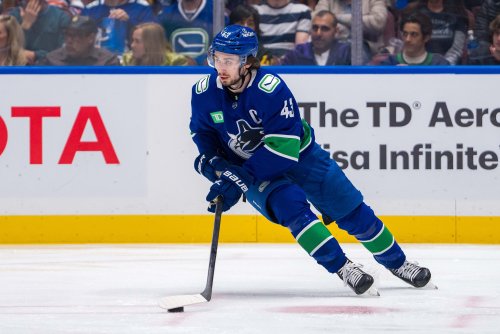


Recommended Comments
Join the conversation
You can post now and register later. If you have an account, sign in now to post with your account.
Note: Your post will require moderator approval before it will be visible.